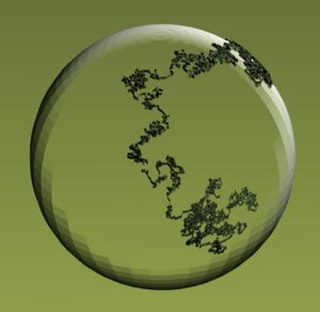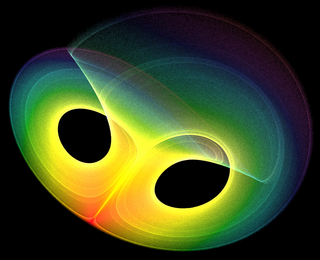
Numerical analysis is the study of algorithms that use numerical approximation for the problems of mathematical analysis. Numerical analysis naturally finds application in all fields of engineering and the physical sciences, but in the 21st century also the life sciences, social sciences, medicine, business and even the arts have adopted elements of scientific computations. The growth in computing power has revolutionized the use of realistic mathematical models in science and engineering, and subtle numerical analysis is required to implement these detailed models of the world. For example, ordinary differential equations appear in celestial mechanics ; numerical linear algebra is important for data analysis; stochastic differential equations and Markov chains are essential in simulating living cells for medicine and biology.

In probability theory and related fields, a stochastic or random process is a mathematical object usually defined as a collection of random variables. Historically, the random variables were associated with or indexed by a set of numbers, usually viewed as points in time, giving the interpretation of a stochastic process representing numerical values of some system randomly changing over time, such as the growth of a bacterial population, an electrical current fluctuating due to thermal noise, or the movement of a gas molecule. Stochastic processes are widely used as mathematical models of systems and phenomena that appear to vary in a random manner. They have applications in many disciplines including sciences such as biology, chemistry, ecology, neuroscience, and physics as well as technology and engineering fields such as image processing, signal processing, information theory, computer science, cryptography and telecommunications. Furthermore, seemingly random changes in financial markets have motivated the extensive use of stochastic processes in finance.

Mathematical analysis is the branch of mathematics dealing with limits and related theories, such as differentiation, integration, measure, infinite series, and analytic functions.
Monte Carlo methods, or Monte Carlo experiments, are a broad class of computational algorithms that rely on repeated random sampling to obtain numerical results. Their essential idea is using randomness to solve problems that might be deterministic in principle. They are often used in physical and mathematical problems and are most useful when it is difficult or impossible to use other approaches. Monte Carlo methods are mainly used in three problem classes: optimization, numerical integration, and generating draws from a probability distribution.
In Itô calculus, the Euler–Maruyama method is a method for the approximate numerical solution of a stochastic differential equation (SDE). It is a simple generalization of the Euler method for ordinary differential equations to stochastic differential equations. It is named after Leonhard Euler and Gisiro Maruyama. Unfortunately, the same generalization cannot be done for any arbitrary deterministic method.
In mathematics of stochastic systems, the Runge–Kutta method is a technique for the approximate numerical solution of a stochastic differential equation. It is a generalisation of the Runge–Kutta method for ordinary differential equations to stochastic differential equations (SDEs). Importantly, the method does not involve knowing derivatives of the coefficient functions in the SDEs.
In the theory of stochastic processes, the filtering problem is a mathematical model for a number of state estimation problems in signal processing and related fields. The general idea is to establish a "best estimate" for the true value of some system from an incomplete, potentially noisy set of observations on that system. The problem of optimal non-linear filtering was solved by Ruslan L. Stratonovich, see also Harold J. Kushner's work and Moshe Zakai's, who introduced a simplified dynamics for the unnormalized conditional law of the filter known as Zakai equation. The solution, however, is infinite-dimensional in the general case. Certain approximations and special cases are well understood: for example, the linear filters are optimal for Gaussian random variables, and are known as the Wiener filter and the Kalman-Bucy filter. More generally, as the solution is infinite dimensional, it requires finite dimensional approximations to be implemented in a computer with finite memory. A finite dimensional approximated nonlinear filter may be more based on heuristics, such as the Extended Kalman Filter or the Assumed Density Filters, or more methodologically oriented such as for example the Projection Filters, some sub-families of which are shown to coincide with the Assumed Density Filters.
Harold Joseph Kushner is an American applied mathematician and a Professor Emeritus of Applied Mathematics at Brown University. He is known for his work on the theory of stochastic stability, the theory of non-linear filtering, and for the development of numerical methods for stochastic control problems such as the Markov chain approximation method. He is commonly cited as the first person to study Bayesian optimization, based on work he published in 1964.
Mathematical finance, also known as quantitative finance, is a field of applied mathematics, concerned with mathematical modeling of financial markets. Generally, mathematical finance will derive and extend the mathematical or numerical models without necessarily establishing a link to financial theory, taking observed market prices as input. Mathematical consistency is required, not compatibility with economic theory. Thus, for example, while a financial economist might study the structural reasons why a company may have a certain share price, a financial mathematician may take the share price as a given, and attempt to use stochastic calculus to obtain the corresponding value of derivatives of the stock. The fundamental theorem of arbitrage-free pricing is one of the key theorems in mathematical finance, while the Black–Scholes equation and formula are amongst the key results.
Mark Herbert Ainsworth Davis is Professor of Mathematics at Imperial College London, working on stochastic processes and mathematical finance. He is known for his contributions to the theory of stochastic processes, stochastic control and mathematical finance.
In probability theory, a piecewise-deterministic Markov process (PDMP) is a process whose behaviour is governed by random jumps at points in time, but whose evolution is deterministically governed by an ordinary differential equation between those times. The class of models is "wide enough to include as special cases virtually all the non-diffusion models of applied probability." The process is defined by three quantities: the flow, the jump rate, and the transition measure.
Wendell Helms Fleming is an American mathematician, specializing in geometrical analysis and stochastic differential equations.

Institute of Mathematics of the National Academy of Sciences of Ukraine is a government-owned research institute in Ukraine that carries out basic research and trains highly qualified professionals in the field of mathematics. It was founded on 13 February 1934.
In queueing theory, a discipline within the mathematical theory of probability, a fluid limit, fluid approximation or fluid analysis of a stochastic model is a deterministic real-valued process which approximates the evolution of a given stochastic process, usually subject to some scaling or limiting criteria.
Mean field particle methods are a broad class of interacting type Monte Carlo algorithms for simulating from a sequence of probability distributions satisfying a nonlinear evolution equation These flows of probability measures can always be interpreted as the distributions of the random states of a Markov process whose transition probabilities depends on the distributions of the current random states. A natural way to simulate these sophisticated nonlinear Markov processes is to sample a large number of copies of the process, replacing in the evolution equation the unknown distributions of the random states by the sampled empirical measures. In contrast with traditional Monte Carlo and Markov chain Monte Carlo methods these mean field particle techniques rely on sequential interacting samples. The terminology mean field reflects the fact that each of the samples interacts with the empirical measures of the process. When the size of the system tends to infinity, these random empirical measures converge to the deterministic distribution of the random states of the nonlinear Markov chain, so that the statistical interaction between particles vanishes. In other words, starting with a chaotic configuration based on independent copies of initial state of the nonlinear Markov chain model, the chaos propagates at any time horizon as the size the system tends to infinity; that is, finite blocks of particles reduces to independent copies of the nonlinear Markov process. This result is called the propagation of chaos property. The terminology "propagation of chaos" originated with the work of Mark Kac in 1976 on a colliding mean field kinetic gas model
Vivek Shripad Borkar is an Indian electrical engineer, mathematician and an Institute chair professor at the Indian Institute of Technology, Mumbai. He is known for introducing analytical paradigm in stochastic optimal control processes and is an elected fellow of all the three major Indian science academies viz. the Indian Academy of Sciences, Indian National Science Academy and the National Academy of Sciences, India. He also holds elected fellowships of The World Academy of Sciences, Institute of Electrical and Electronics Engineers, Indian National Academy of Engineering and the American Mathematical Society. The Council of Scientific and Industrial Research, the apex agency of the Government of India for scientific research, awarded him the Shanti Swarup Bhatnagar Prize for Science and Technology, one of the highest Indian science awards for his contributions to Engineering Sciences in 1992. He received the TWAS Prize of the World Academy of Sciences in 2009.





